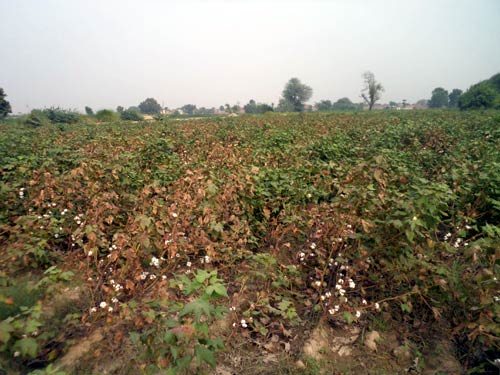Fungal Blight/Rust on Upland Cotton and its Control
 By
Shehzad Ahmad Kang
By
Shehzad Ahmad Kang
Department of Plant Breeding and Genetics, University of
Agriculture, Faisalabad, Pakistan.
Introduction
Upland cotton {Gossypium hirsutum (2n = 52}) is cash
crop of Pakistan. Majority of industries based on cotton
crop, so it is known as back bone of Pak economy. Season
2011-2012 Pakistan produced over 15 million bales
(Anonymous, 2011-12). Last year (2011) and current season
cotton crop was severely affected by leaf/stem blight or
rust. This fungal disease caused by an organism Rhizoctonia
solani which primarily attacks seeds of plants below the
soil surface, but can also infect bolls, roots, leaves and
stems. The most common symptom of Rhizoctonia is "damping
off", or the failure of infected seeds to germinate.
Rhizoctonia solani may invade the seed before it has
germinated to cause this pre-emergent damping off, or it can
kill very young seedlings or mature plants. Seeds that do
germinate before being killed by the fungus have
reddish-brown lesions and cankers on stems, leaves and
roots.
There are various environmental conditions that put the
plant at higher risk of infection due to Rhizoctonia, The
pathogen prefers warmer wet climates for infection and
growth. Post-emergent damping off is a further delay in
attack of Rhizoctonia solani. The seedling is most
susceptible to disease in its juvenile stage in patches
form.
Rhizoctonia solani can also cause hypocotyl and stem cankers
on mature plants of cotton. Strands of mycelium and
sometimes sclerotia appear on their surfaces. Roots will
turn brown and die after a period of time. The fungus has a
wide host range. Strains of Rhizoctonia solani may differ in
the hosts they are able to infect, the virulence of
infection, selectivity for a given host ranging from
non-pathogenic to highly virulent, the temperature at which
infection occurs, the ability to develop in lower soil
levels, the ability to form sclerotia, the growth rate, the
survival in a certain area. Rhizoctonia attack start from
zero node (soil surface) to upper nodes, leaves and whole
plant.
Environment
The pathogen is known to prefer warm wet weather, and out
breaks typically occur in the early summer months. Most
symptoms of the pathogen do not occur until late summer and
thus most farmers do not become aware of the diseased crop
until harvest. A combination of environmental factors have
been linked to the prevalence of the pathogen such as:
presence of host plant, frequent rainfall/irrigation and
increased temperatures in spring and summer. In addition, a
reduction of drainage of the soil due to various techniques
such as soil compaction is also known to create favorable
environments for the pathogen. The pathogen is dispersed as
sclerotia, and these sclerotia can travel by means of wind,
water or soil movement between host plants. Diseases caused
by this pathogen are more severe in soils that are
moderately wet and a temperature range of 15-18 degrees C.
Management
It is not possible to completely control Rhizoctonia, but
the severity of the pathogen can be limited. Successful
control of Rhizoctonia depends on characteristics of the
pathogen, host crops, and environment. Controlling the
environment, crop rotation, using resistant varieties, and
minimizing soil compaction are effective and noninvasive
ways to manage disease. Planting seedlings in warmer soil
and getting plants to emerge quickly helps minimize damage.
Crop rotation also helps minimize the amount of inoculum
that causes Rhizoctonia Solani. Minimizing soil compaction
is also another way to reduce risk of the pathogen because
this helps water infiltration, drainage, and aeration for
the plants.
One specific chemical option is a chemical spray PCNB which
is known to be the best solution to reducing damping off of
seeds on host plants. To minimize disease, we can use plant
certified seed that is free of sclerotia. Seed growers
should look into only purchasing sclerotia free seeds when
planting their crops since sclerotia can over winter in the
soil and may not show symptoms right away. Although
fungicides are not the most effective way to manage this
pathogen, there have been a few that have been approved by
the USDA for control of the pathogen.
Control by Fungicides
One should consult their chemical representative on which
group of fungicides would be most effective with their crops
in regard to Rhizoctonia solani. Spray the infected cotton
field by the application recommended fungicide viz.
Metalaxyl + Mancozeb @ 2.5g/liter of water OR
Thiophanate methyl @ 2.5g/liter of water OR
Copper oxychloride @ 3g/liter of water OR
Difenoconazole @ 20ml/liter of water OR
Propineb @ 125g/liter of water.
Corresponding authorís email:
shehzadpbg@gmail.com
Courtesy: PAKISSAN Team